Two Weeks in the Life of the Hive
...

The weekend before last, we opened up both of our beehives. It had been far too long, since we had inspected, and the Gloriana hive was terribly overcrowded.
The bees had run out of room in the hive proper, and were shoving honey anywhere they could. They had built extra honey comb on the tops of their frames, because there was no other storage space.
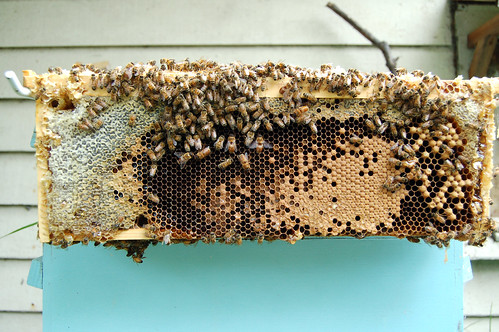
The developing bees in the capped brood cells were surrounded by uncapped nectar and capped honey. The food stores were encroaching on the nursery.
Robb and I had read that a hive will swarm when it runs out of places for the queen to lay her eggs. The bees had been busier than we expected, and things were getting dangerously crowded.
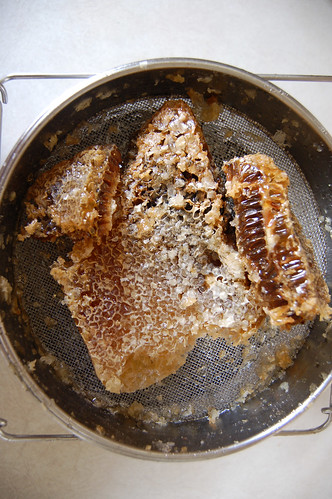
We added another box of open frames on to the beehive, and harvested four frames of honey.

The honey seemed darker than what we had taken out of the hive, previously. However, when we actually strained the honey, it was light and clear. Perhaps the older, darker wax made the honey appear darker?
We extract our honey using the crush-and-strain method. Our local bee club owns a couple of mechanical extractors, but actually borrowing them is a real pain in the patoot (or so it seems to me, judging from the heated discussion at the bee meetings). We cut out the nicest comb, and carefully place that in jars. Then we mush up the other comb, and let it drain through fine metal sieves. We collect the honey in a special bucket, which is fitted with a "honey gate" that's allows for (reasonably) easy filling of our jars. It's a messy process, and we end up with sticky drawer-pulls and doorknobs before we're all done. Thankfully honey is completely water-soluble, so cleanup isn't too arduous.
Robb figures that we got something like seventeen pounds of honey, as well as a pound of beautiful golden beeswax.
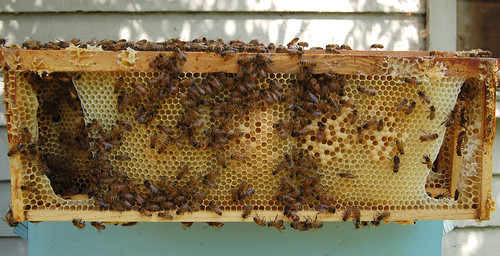
Here's what we found, when we opened the hive today. Lots of newly-constructed wax comb. Remember, we cut all of the comb out of the frames, when we harvested.
The bees built all of this in fewer than fifteen days. In fact, they must have built all of this in about three days, because if I've got the "bee math" right, the capped brood in the center of the frame can be no younger than twelve days old.
You can see that the bees have not built the comb wall-to-wall, quite yet. You can also see that when we cut out the honeycomb, we always leave a bit of the comb behind, as a building guide for the bees. Do you notice the comb on the outer edges of the frame? That was probably in place from after our harvest. The bees will eventually fill in the entire frame, leaving just a few open spaces, as travel corridors.
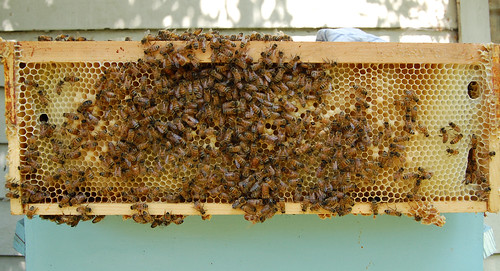
We've found it fascinating that the bees will construct neat little holes in their wax comb. We often observe bees passing through these passageways.
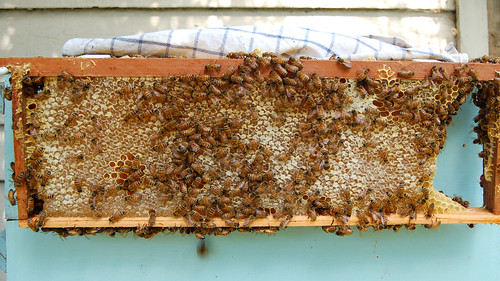
This is two week's worth of nectar collection. The bees have built comb, brought in nectar, processed it with enzymes, evaporated the excess water, and capped the finished honey.
It is said that bees travel an average of 1600 round trips -- of up to 6 miles per trip -- to collect enough nectar to make a single ounce of honey. Put another way, bees travel a distance equal to 4 times around the earth in order to produce just 2 pounds of honey. One reads a lot of bee statistics, and I'm always a bit skeptical of their accuracy.
Regardless, one has to admire the amount of work the bees accomplished in such a short period of time. They re-filled a hive that we had harvested just two before.
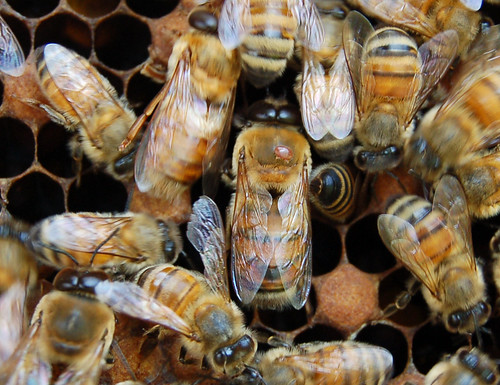
There were a few unpleasant discoveries, during the course of this inspection. I spotted a parasitic varroa mite attached to one of the colony's drones.
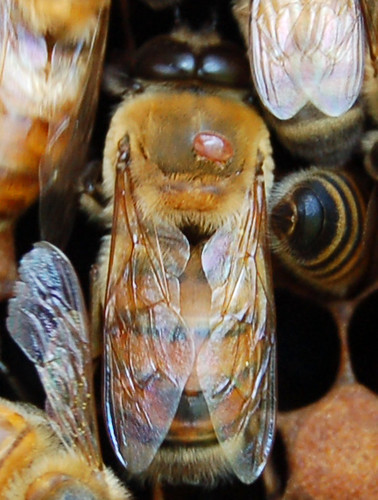
Here's a blow-up of the previous photo. Even with the lack of clarity, the parasite is evident. It looks like a brick-red crab, sucking the life out of this bee. Varroa are a huge problem for beekeepers, both because of the damage they inflict on the colony, and because there don't seem to be many safe products for combating these revolting pests. The mites continue to develop resistances to the miticides.
This year, our apparent varroa load is lower than last. We interrupted the brood cycle of our bees when we split the colony back in the spring. By interrupting the bee's reproductive cycle, we also smashed the life-cycle of their parasites.
This is a non-chemical approach to varroa management that has, it seems, worked for us this season.
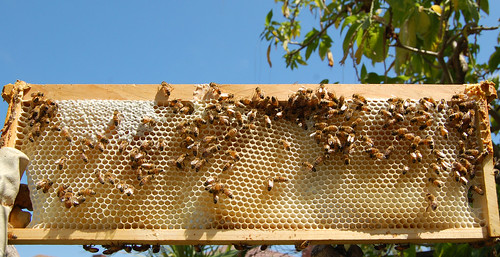
Overall, we were delighted by what we found in this hive. We completed our inspection by adding a sixth hive box, and interspersing existing comb with empty frames. This seems to help the bees build straight comb, that doesn't get ripped when we open up their house.
The new honey comb really is beautiful, isn't it? Also, our sky really is that blue.

The weekend before last, we opened up both of our beehives. It had been far too long, since we had inspected, and the Gloriana hive was terribly overcrowded.
The bees had run out of room in the hive proper, and were shoving honey anywhere they could. They had built extra honey comb on the tops of their frames, because there was no other storage space.

The developing bees in the capped brood cells were surrounded by uncapped nectar and capped honey. The food stores were encroaching on the nursery.
Robb and I had read that a hive will swarm when it runs out of places for the queen to lay her eggs. The bees had been busier than we expected, and things were getting dangerously crowded.

We added another box of open frames on to the beehive, and harvested four frames of honey.

The honey seemed darker than what we had taken out of the hive, previously. However, when we actually strained the honey, it was light and clear. Perhaps the older, darker wax made the honey appear darker?
We extract our honey using the crush-and-strain method. Our local bee club owns a couple of mechanical extractors, but actually borrowing them is a real pain in the patoot (or so it seems to me, judging from the heated discussion at the bee meetings). We cut out the nicest comb, and carefully place that in jars. Then we mush up the other comb, and let it drain through fine metal sieves. We collect the honey in a special bucket, which is fitted with a "honey gate" that's allows for (reasonably) easy filling of our jars. It's a messy process, and we end up with sticky drawer-pulls and doorknobs before we're all done. Thankfully honey is completely water-soluble, so cleanup isn't too arduous.
Robb figures that we got something like seventeen pounds of honey, as well as a pound of beautiful golden beeswax.

Here's what we found, when we opened the hive today. Lots of newly-constructed wax comb. Remember, we cut all of the comb out of the frames, when we harvested.
The bees built all of this in fewer than fifteen days. In fact, they must have built all of this in about three days, because if I've got the "bee math" right, the capped brood in the center of the frame can be no younger than twelve days old.
You can see that the bees have not built the comb wall-to-wall, quite yet. You can also see that when we cut out the honeycomb, we always leave a bit of the comb behind, as a building guide for the bees. Do you notice the comb on the outer edges of the frame? That was probably in place from after our harvest. The bees will eventually fill in the entire frame, leaving just a few open spaces, as travel corridors.

We've found it fascinating that the bees will construct neat little holes in their wax comb. We often observe bees passing through these passageways.

This is two week's worth of nectar collection. The bees have built comb, brought in nectar, processed it with enzymes, evaporated the excess water, and capped the finished honey.
It is said that bees travel an average of 1600 round trips -- of up to 6 miles per trip -- to collect enough nectar to make a single ounce of honey. Put another way, bees travel a distance equal to 4 times around the earth in order to produce just 2 pounds of honey. One reads a lot of bee statistics, and I'm always a bit skeptical of their accuracy.
Regardless, one has to admire the amount of work the bees accomplished in such a short period of time. They re-filled a hive that we had harvested just two before.

There were a few unpleasant discoveries, during the course of this inspection. I spotted a parasitic varroa mite attached to one of the colony's drones.

Here's a blow-up of the previous photo. Even with the lack of clarity, the parasite is evident. It looks like a brick-red crab, sucking the life out of this bee. Varroa are a huge problem for beekeepers, both because of the damage they inflict on the colony, and because there don't seem to be many safe products for combating these revolting pests. The mites continue to develop resistances to the miticides.
This year, our apparent varroa load is lower than last. We interrupted the brood cycle of our bees when we split the colony back in the spring. By interrupting the bee's reproductive cycle, we also smashed the life-cycle of their parasites.
This is a non-chemical approach to varroa management that has, it seems, worked for us this season.

Overall, we were delighted by what we found in this hive. We completed our inspection by adding a sixth hive box, and interspersing existing comb with empty frames. This seems to help the bees build straight comb, that doesn't get ripped when we open up their house.
The new honey comb really is beautiful, isn't it? Also, our sky really is that blue.

Comments
Thanks for any advice,
Kathy
You commented on my blog and asked for a photo of my irregular brood...well I didn't take one darn it and will have to do that another time. I'm do to go in again too.
BTW: It's not that bad--renting the extractor from the club. The electric extractor works really well. I couldn't get my honey to drain, because it was too thick I guess (with the method you are using). But whatever is works is fine eh? I haven't been to a meeting in ages.
I am in awe of the photos and detail which you captured in your post.
I don't keep bees or even know anyone who does but the whole process was fascinating to see in close up detail.